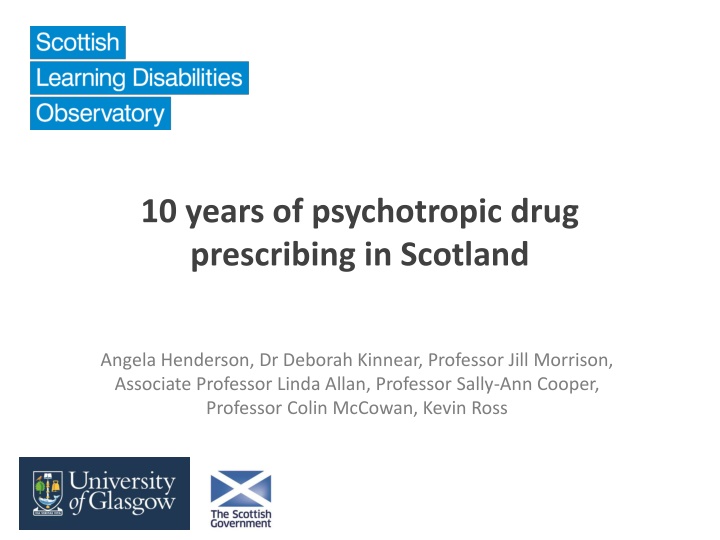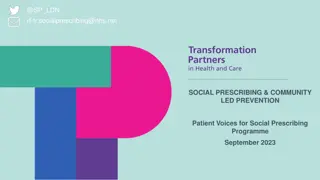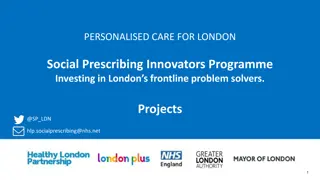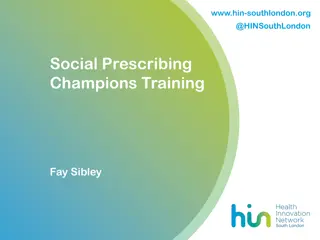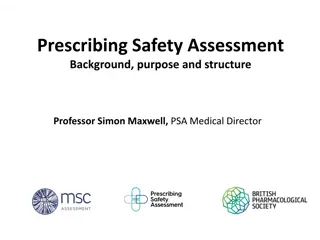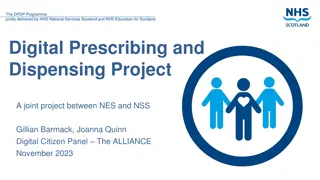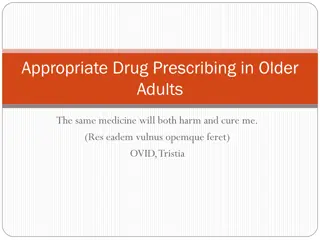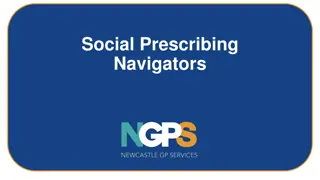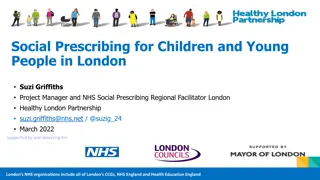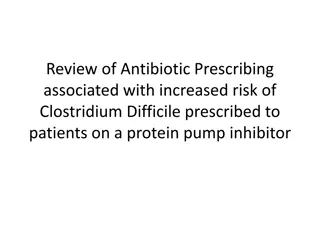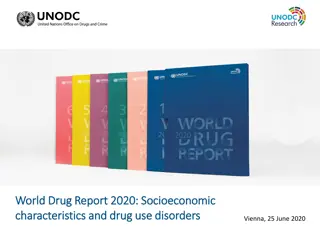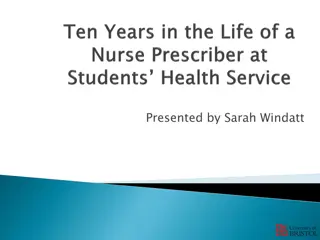Psychotropic Drug Prescribing Trends in Intellectual Disabilities Population
Analyzing 10 years of psychotropic drug prescribing in Scotland for individuals with intellectual disabilities, focusing on antipsychotic medication usage and clinical justification. The study aims to examine trends in prescribing patterns and the impact on health outcomes, utilizing data from Scotland's largest health board. Two data sources were used in this longitudinal cohort study, involving adults with learning disabilities aged 16 and over, to assess the prevalence and justification of antipsychotic medication prescriptions between 2002 and 2014.
Download Presentation

Please find below an Image/Link to download the presentation.
The content on the website is provided AS IS for your information and personal use only. It may not be sold, licensed, or shared on other websites without obtaining consent from the author.If you encounter any issues during the download, it is possible that the publisher has removed the file from their server.
You are allowed to download the files provided on this website for personal or commercial use, subject to the condition that they are used lawfully. All files are the property of their respective owners.
The content on the website is provided AS IS for your information and personal use only. It may not be sold, licensed, or shared on other websites without obtaining consent from the author.
E N D
Presentation Transcript
10 years of psychotropic drug prescribing in Scotland Angela Henderson, Dr Deborah Kinnear, Professor Jill Morrison, Associate Professor Linda Allan, Professor Sally-Ann Cooper, Professor Colin McCowan, Kevin Ross
Background Concern over the use of antipsychotic medication for people with intellectual disabilities and people with autism. Antipsychotic medications are over prescribed in this population Need for better evidence relating to efficacy, safety and health impacts of antipsychotic medication Particular concerns that these drug are used: Without clinical justification, for example to manage problem behaviour Without appropriate reviews Without acknowledging their impact on peoples health
Research literature High levels of variability in rate of prescribing of antipsychotic medications due to methodological limitations Public Health England review of psychotropic medications in General Practice - prescribing in absence of clinical justification/evidence Preliminary evidence may suggest a decline in the use of antipsychotic drugs has also been reported since 1999 (Sheehan et al., 2015)
Study aims Analyse data from Scotland's largest health board to examine: Trends in prescribing of psychotropic medications in intellectual disabilities population, in 2002/04 (T1), 2004/06 (T2)and 2014 (T3) The number of people with intellectual disabilities who are prescribed antipsychotic medication The extent to which antipsychotic medications are prescribed in the absence of accepted clinical justification (T1 and T2) Trends in prescribing of psychotropic drugs in population with intellectual disabilities between 2004 and 2014
Methods 2 data sources: Large sample (n=648), longitudinal, prospective cohort study: Case ascertainment, adults with learning disabilities, aged 16 and over: Known to social work services Local authority funding Local NHS intellectual disability services Primary care services - GP incentivisation People individually consented at T1, 2002 2004 and at T2, 2004 - 2006 Electronic extraction of data from the same health board area, people on intellectual disabilities register, 2014 (n=4065), T3
Participant assessment, T1 and T2 Detailed assessment of each participant by trained practitioners (nurses and GPs): Face to face assessment Case note review Identification of possible mental-ill health: Rigorous review and assessment by specialist psychiatrist Diagnostic criteria applied Consensus meeting between project psychiatrists Determination of ability level
Participant identification, T3 Data extracted from primary care management information systems Adults with intellectual disabilities Linkage to national prescribing dataset Analysis of records to determine: Psychotropic medications prescribed Quality of recording data CHI linkage to cohort at T1 and T2 (awaiting additional permissions)
Cohort characteristics 2014 2002 - 2004 54.5% men 45.5% women Mean age 44 years Median age 44 (SD 14.6) (range 16 81) 2006 58.0% men 42.0% women Mean age 44 years Median (IQR) 45 54.5% men 45.5% women Mean age 46 years Median age 46(SD 14.6) (range 18 - 81)
Level of intellectual disabilities Living arrangements T1 % (n=648) T2 % (n=648) T3 % (n=4,065) T1 % T2 % Family carer 35.5 39.4 Mild 39.5 39.5 26.0 independent 9.2 7.6 Moderate 29.0 29.1 21.6 Paid support 47.1 46.3 Severe 18.2 18.1 15.2 Congregate setting 8.2 6.8 Profound & Multiple 13.3 13.3 4.8 Not recorded 0.0 0.0 Not recorded 0.0 0.0 32.4
Prescribing patterns T1, T2 & T3 T1 T2 T3 % (648) % (648) % (4065) Any psychotropic drug 46.1 (306) 45.2 (292) 47.9 (1948) Antipsychotics 23.0 (149) 20.1(130) 16.4 (665) Antiepileptics 25.2 (163) 23.9 (155) 25.6 (1039) Lithium 1.5 (10) 0.5 (3) 1.1 (45) Antidepressants 11.3 (73) 15.6 (101) 18.9 (770) Hypnotics & anxiolytics 5.9 (38) 6.5 (42) 8.6 (348)
10 year prescribing trend 30 25 Antipsychotic drugs 20 Percentage Antidepressants 15 Hypnotics & anxiolytics 10 5 Antiepileptics 0 2002/2004 2004/2006 Year 2014
Mental health T1, T2 & T3 Following comprehensive assessment of all participants (n=648) at T1 & T2: 37.2% (n=241) diagnosed with a mental health disorder 6.0% (n=39) diagnosed with psychosis 18.4% (n=119) problem behaviours Analysis of psychosis register at T3: 6.7% (272) recorded as having psychosis
Mental health conditions of people taking an antipsychotic drug, excluding those with psychosis Other conditions assessed (excluding people with psychosis) N Takes antipsychotic drug T1 n(%) 42 (37.2) 17 (37.8) 7 (23.3) 9 (81.8) 5 (50.0) 3 (30.0) 4 (30.8) 2 (28.6) T2 n(%) Problem behaviours Autism Spectrum Disorder Depression Attention Deficit Hyperactivity Disorder Eating disorder, including pica Generalised anxiety disorder Organic disorder Other mental ill-health 113 45 30 11 10 10 13 40 (35.4) 12 (26.7) 8 (26.7) 7 (63.6) 5 (50.0) 2 (20.0) 1 (7.7) 2 (28.6) 3 (50.0) 5 (27.8) 7 3 (50.0) 3 (16.7) Personality disorder Any phobia 6 18 1 (33.4) Obsessive Compulsive Disorder 3 1 (33.4) 1 (100.0) Psychosexual disorder 1 1 (100.0) 45 (11.1) No mental health problem 407 44 (10.8)
At T1 118 (18.2%) people who did not have psychosis were prescribed an anti psychotic drug At T2 104 (16.0%) people who did not have psychosis were prescribed an anti psychotic drug Of these: 35.6% (n=42) had at least one problem behaviour at T1, and 38.5% (n=40) at T2 38.1% (n=45) had no past or present mental health disorder at T1, and 42.3% (n=44) at T2!
Strengths: Comprehensive psychiatric assessment and full case note review at T1 and T2 Potential contribution to longer term study through further linkage Data drawn from Scotland's largest health board area (almost 20% of Scotland) Longitudinal data Limitations: Participants drawn from only one health board area does not capture local variation in practice T3 data does not contain comprehensive diagnostic information
Implications Trends are moving in the right direction but significant action needs to be taken to ensure that people with intellectual disabilities receive the best possible care Further research is needed to establish rate of change in patterns of prescribing and association with clinical diagnoses at a national level in Scotland Findings reassert need for longitudinal studies to help inform practice change Side effects potentially contribute to the significant health inequalities experienced by people with intellectual disabilities Concerted action to review and further reduce antipsychotic prescribing rates in this population Psychosocial interventions?
Thank you! www.sldo.ac.uk @ScotLDO +44 (0)141 211 0688 Angela.henderson@glasgow.ac.uk
